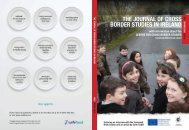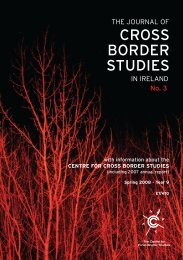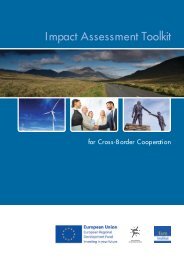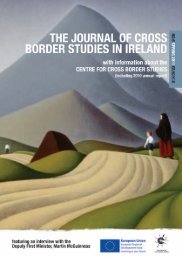improving government service delivery to minority ethnic ... - NCCRI
improving government service delivery to minority ethnic ... - NCCRI
improving government service delivery to minority ethnic ... - NCCRI
You also want an ePaper? Increase the reach of your titles
YUMPU automatically turns print PDFs into web optimized ePapers that Google loves.
Prospects for ongoing strong immigration<br />
The Irish economy is extremely exposed <strong>to</strong> global trends, because of its dependence on foreign direct<br />
investment and its extremely export-driven growth patterns. However, barring unforeseeable catastrophic<br />
events, current projections suggest that continuing strong growth is likely. The Economic and Social Research<br />
Institute’s Medium Term Review 2003-2010 suggests that employment is likely <strong>to</strong> grow by a further 220,000<br />
jobs between 2005 and 2010, generating further net immigration of at least 100,000 for the period.<br />
In addition, the Government appears <strong>to</strong> be moving <strong>to</strong>wards a regime which recognises a continuing need<br />
for some high-skilled migration from outside the EEA. The assumption seems <strong>to</strong> be that migrants from the<br />
new accession states will take the less skilled posts, which in fact appears <strong>to</strong> be happening (although many<br />
have post-second level education). These patterns may change as other EU member states open their labour<br />
markets. Media reports suggest that the Government is unlikely <strong>to</strong> extend free access <strong>to</strong> the Irish labour market<br />
<strong>to</strong> the next accession states (Romania and Bulgaria in 2007), at least as long as a number of the major member<br />
states still have not opened their borders <strong>to</strong> the first accession states.<br />
212_National Economic<br />
and Social Council (2005),<br />
NESC Strategy 2006:<br />
People, Productivity and<br />
Purpose.<br />
213_The Total Fertility Rate<br />
(the number of children a<br />
woman of child-bearing<br />
age is expected <strong>to</strong> have<br />
in her childbearing years)<br />
is currently 1.98, slightly<br />
below the replacement level<br />
of 2.1.<br />
The effects of high levels of immigration are now visible across the geographical, economic, social, religious<br />
and cultural landscapes of Ireland. Goods and <strong>service</strong>s aimed at <strong>ethnic</strong> niche markets, new revivalist churches<br />
and other faith communities, print and electronic media in various languages, the challenges of increasingly<br />
multilingual and multi<strong>ethnic</strong> school, workplace and community environments, the need for more effective action<br />
against racism and discrimination, are all testimony <strong>to</strong> the scale of change. For the first time, the 2006 Census<br />
form was translated in<strong>to</strong> 11 languages as well as Irish and English and information on completing the Census<br />
form was provided in a further five languages; it also contained a new question on <strong>ethnic</strong>ity.<br />
Demographic Projections<br />
In a comparative context, Ireland’s current demographic change is unique in Europe. Projections suggest<br />
that Ireland’s population could reach 5 million in 2030, which could exceed the population of Scotland for<br />
the first time since the foundation of the State. The present population of Ireland is just over 4 million and the<br />
percentage of foreign-born people could exceed 1 million in 2030, compared with 400,000 at the time of 2002<br />
census. This would equate <strong>to</strong> about 18% of the population in 2030, higher than the present rate of all EU<br />
countries, including those that have experienced high levels of inward migration in the past. 212<br />
The recent and projected population increase in Ireland are the result of two main fac<strong>to</strong>rs, firstly the continuing<br />
comparatively high fertility rates in Ireland 213 and the level of net inward migration (which continues <strong>to</strong> include a<br />
significant, though declining proportion of returning Irish emigrants).<br />
These dramatic projections have significant implications for policy makers and <strong>service</strong> provision in Ireland<br />
through the creation of additional demands on <strong>service</strong>s and in ensuring that the way that <strong>service</strong>s are delivered<br />
takes account of this increased diversity.
















